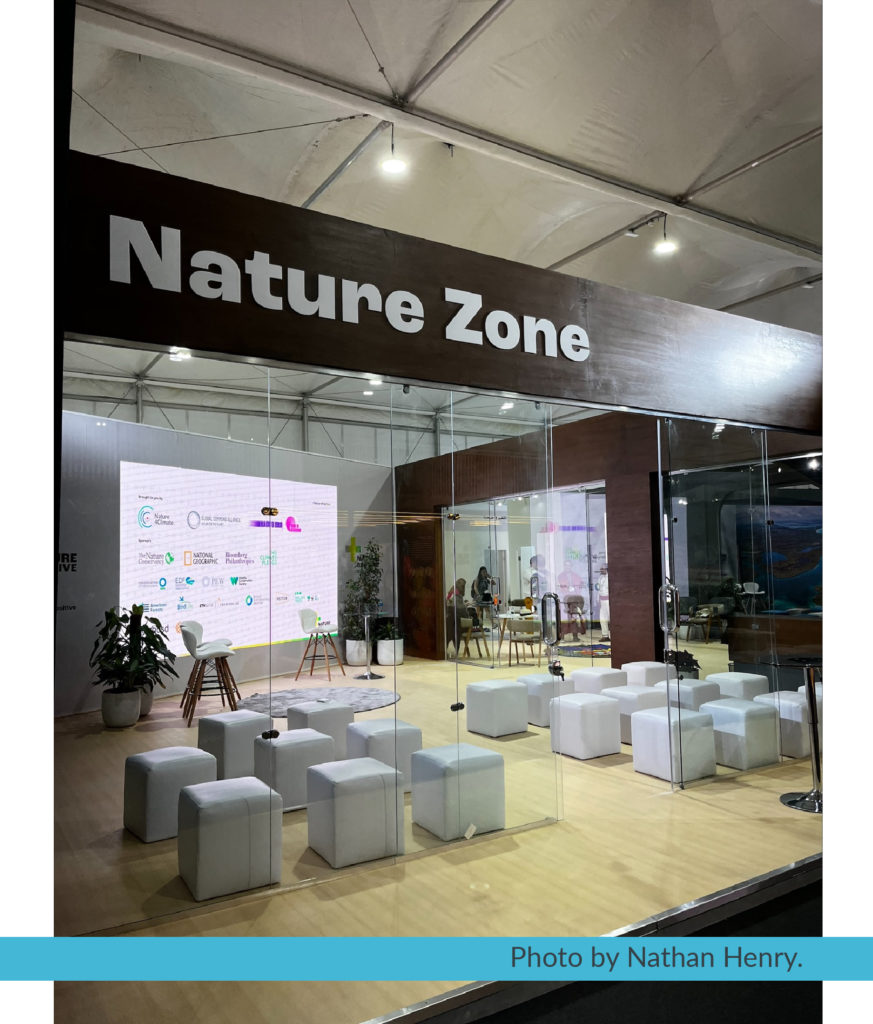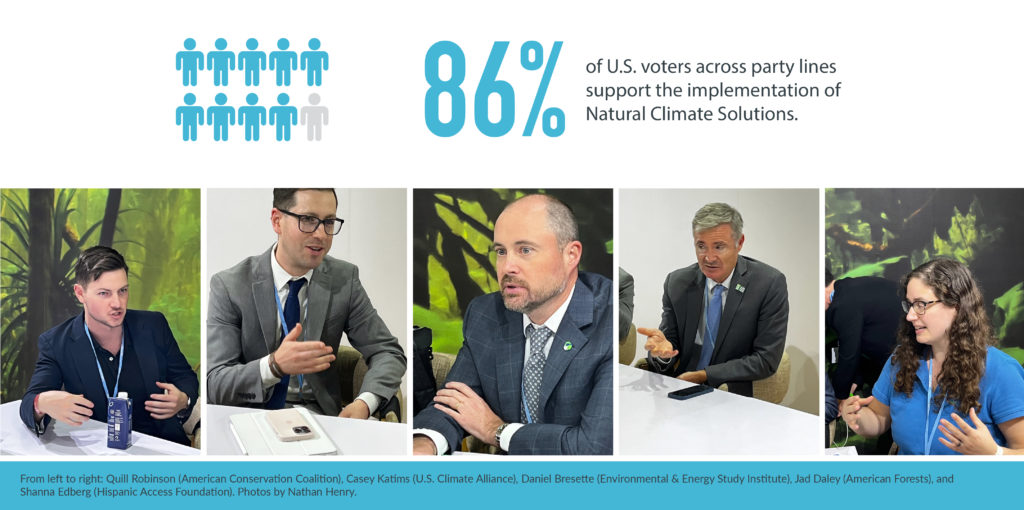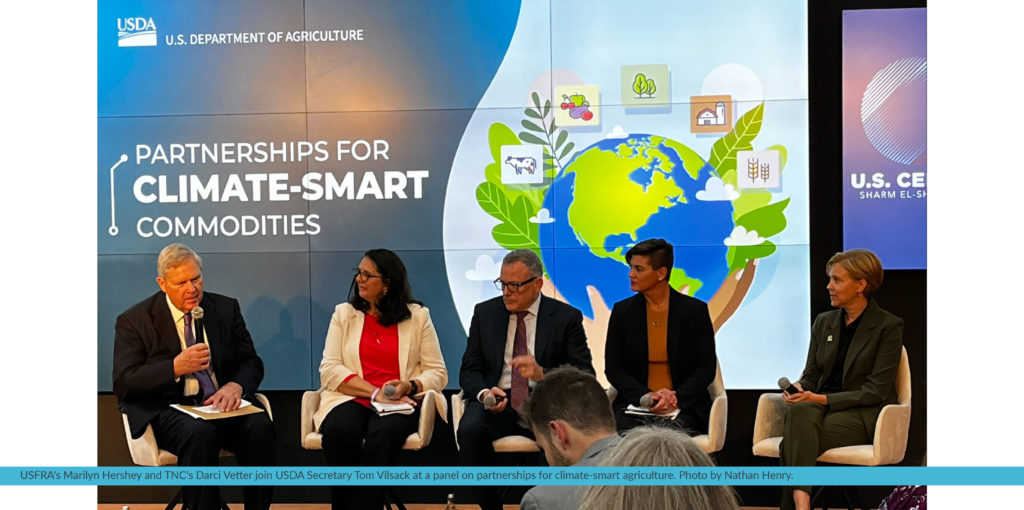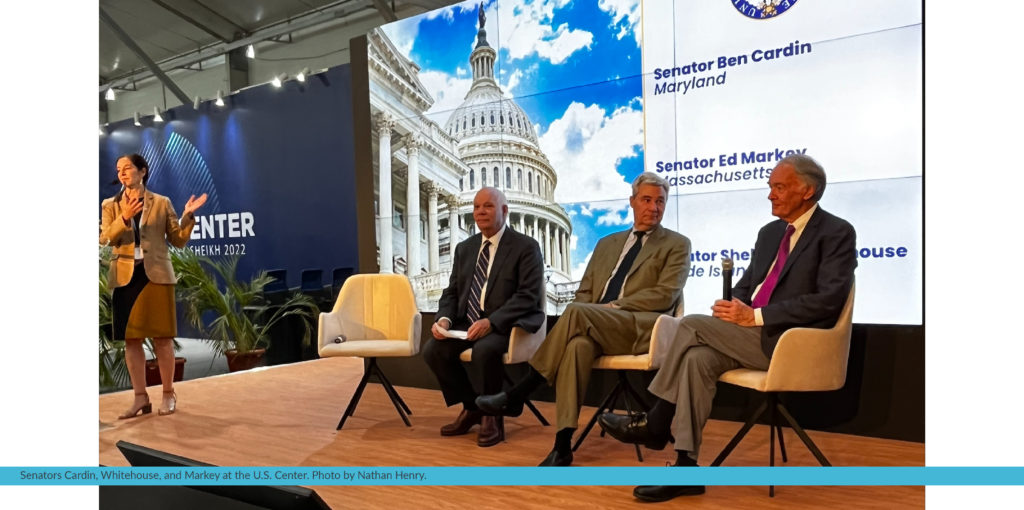Last updated on January 25th, 2024
Unless you are a snorkeler or a scuba diver, it is likely you may have never heard of Sharm El Sheikh, Egypt. Yet for two weeks, this dusty seaside resort town served as the heart of the climate action universe. Government officials and activists from all over the world converged for COP27 – a yearly rite of passage in global efforts to act collectively to prevent a climate catastrophe that is already offering the world a disturbing preview of a challenging future.
As U.S. Nature4Climate’s Program Director, I spent a week at COP27. This was my first COP, and walking into the Convention Center for the first time, I had no idea what to expect. For most of my time at the conference, I was stationed in the Nature Zone Pavilion – a collaborative effort, led by Nature4Climate and sponsored by a diverse array of partners – including The Nature Conservancy, American Forests, Environmental Defense Fund, Conservation International, Pew Charitable Trusts, and World Resources Institute. The pavilion served to highlight the powerful role that nature can play in mitigating climate change.

Buzzing With Energy and Activity
The Nature Zone was located in the farthest corner of the conference center’s farthest building, and walking there was like taking a trip around the world in 10 minutes. The Children and Youth Pavilion was bursting at the seams, not just with people, but with the passion of a generation that knows it will be paying the bill if the world fails to take effective action to address climate change. The well-organized U.S. Center was also a beehive of activity. If you wanted to catch a congressperson or an undersecretary, this was the place to be. Passing by the Coalition for Rainforest Nations pavilion, I happened upon a crowd during one trip across the conference center. As the audience watched with a mixture of bewilderment and curiosity, we were treated to a unique rap performance – focused on carbon credits.
Populating the pavilions was a diverse ecosystem of people speaking dozens of different languages, hailing from all parts of the world. Activists wearing t-shirts and collecting buttons who were just happy to be there. Students from Harvard, Appalachian State, and Washington University – the next generation of climate leaders. Earnest government staffers scouting locations a day in advance so as not to waste a minute of their principal’s time. Harried pavilion personnel frantically dealing with catering snafus and A/V disasters. Also amongst the crowd? More than a dozen U.S. Nature4Climate coalition members and collaborators, highlighting the important role that Natural Climate Solutions can play in mitigating climate change.

A Wide Path Forward for Natural Climate Solutions

U.S. Nature4Climate was proud to hold a launch event featuring American Forests, the Environmental & Energy Study Institute, the Hispanic Access Foundation, the American Conservation Coalition, and the U.S. Climate Alliance, U.S. Nature4Climate, releasing the results of a survey of 1,000 registered U.S. voters demonstrating overwhelming support (86%) for expanding implementation of Natural Climate Solutions, with Democrats (96%), independents (81%), and Republicans (81%) all supportive by wide margins. These results suggest that, even with a divided government in the U.S., there is a wide path forward for additional investment in Natural Climate Solutions.
Major Announcements for nature
The Nature Conservancy’s (TNC) contingent was everywhere, with CEO Jennifer Morris and Global Policy Head Darci Vetter leading the charge. I suspect that Vetter had a time-turner in her pocket – popping up on panels across the length and breadth of the Conference Center, seemingly simultaneously. TNC highlighted efforts to promote innovative climate financing, such as “Blue Bonds,” helped amplify the role that agriculture can play in addressing climate change, and highlighted the need for a framework that puts nature at the heart of efforts to address both the climate and biodiversity crises.

American Forests’ Jad Daley made not one, not two, but three major announcements, all featuring large numbers. A $10 million Tree Equity Catalyst Fund will help communities around the U.S. access IRA funding to plant urban trees. A commitment by USAID to conserve, restore, and manage 100 million hectares of forest worldwide. Pledges by 1t.org US members to conserve, restore, and grow 55 billion trees by 2030.
The Hispanic Access Foundation’s Shanna Edberg launched a new report: 10 Ways Access to Nature Can Bolster Biodiversity, Communities, and Climate, will help policymakers, advocates, and communities identify high-leverage opportunities to invest in efforts that benefit biodiversity, human communities, and while also helping to mitigate climate change.
U.S. Farmers & Ranchers in Action’s (USFRA) Erin Fitzgerald and Marilyn Hershey must have borrowed Darci Vetter’s time-turner, because they were also ubiquitous at COP— discussing sustainable dairy in one pavilion, and promoting the promise of Partnership for Climate-Smart Commodities with USDA Secretary Tom Vilsack at another. USFRA had a mission to highlight the role agriculture can play as a climate solution. Their busy schedule suggests their message was in demand.
U.S. Climate action in the spotlight
Leading a delegation of two governors and agency officials from five states, the U.S. Climate Alliance highlighted subnational leadership on climate change. They showed how innovative climate actions in states like Washington, New Mexico, and California can light the path forward for broader-scale efforts at the federal, and even global, level. These efforts were bolstered by the Pew Charitable Trust, which also highlighted subnational action on implementing blue carbon strategies in the United States.

To help bridge the partisan divide around climate change, the American Conservation Coalition, in collaboration with TNC, Dream.Org, the U.S. Chamber of Commerce, and the Atlantic Council, led the Building Bridges Summit, a series of fireside chats featuring leaders from the non-profit and corporate sectors working to find common ground on climate solutions. I had the chance to attend part of the summit, and was heartened by the collaborative, solutions-oriented spirit of its attendees.
Providing important context about COP27 to policy makers back home, the Environmental & Energy Study Institute’s (EESI) briefing series, “What Congress Needs to Know About COP27” set the table for this year’s negotiations, while taking a deeper-dive into issues like Natural Climate Solutions, and climate change loss and damage. EESI’s Daniel Bresette and Anna McGinn provided daily updates during COP from Egypt, and a post-COP recap briefing examined what happened at COP and why the negotiations matter to U.S. policy makers.
A chaotic and rewarding experience
The World Resources Institute, Ceres, Ocean Conservancy, Environmental Defense Fund, Conservation International, and Center for American Progress also had active presences at COP27, participating in dozens of events and providing leadership on both science and policy tools for implementing Natural Climate Solutions and other climate change mitigation strategies.
Attending COP27 was a chaotic experience – so much is happening in so many places at the same time – but it was also a rewarding one. I am proud of our USN4C coalition members who worked exceptionally hard to ensure that Natural Climate Solutions remain at the center of the broader effort to address climate change. While we recognize these solutions alone cannot solve the climate crisis – and must be undertaken in tandem with efforts to decarbonize the energy and transportation sectors – we also recognize they are win-win strategies with numerous additional benefits for people and the environment.
COP27 is over, but the work continues to get this message out.
Read the News4Climate Newsletter Special Edition on COP27 for a round-up of our coalition members’ events and announcements at COP27.
